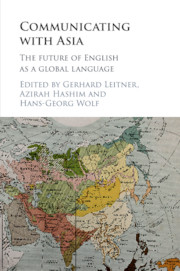Book contents
- Communicating with Asia
- Communicating with Asia
- Copyright page
- Contents
- Figures
- Tables
- Contributors
- Book part
- Communicating with Asia: introduction
- Part I English in selected regional and national habitats with a glance at the role of outward-bound communication needs
- Part II Major other languages in Asia, their international status and impact on education
- 10 Multilingualism, Hindi–Urdu and Indian English: intranational and international diaspora
- 11 Bahasa Indonesia and Bahasa Melayu: convergence and divergence of the official languages in contemporary Southeast Asia
- 12 Putonghua and Cantonese in the Chinese territories
- 13 The Chinese language in the Asian diaspora: a Malaysian experience
- 14 Russian in Far East Asia: linguistic policies on the periphery of empire
- 15 Russian and Turkic languages in Central Asia
- Part III Wider perspectives
- Bibliography
- Index
13 - The Chinese language in the Asian diaspora: a Malaysian experience
from Part II - Major other languages in Asia, their international status and impact on education
Published online by Cambridge University Press: 05 January 2016
- Communicating with Asia
- Communicating with Asia
- Copyright page
- Contents
- Figures
- Tables
- Contributors
- Book part
- Communicating with Asia: introduction
- Part I English in selected regional and national habitats with a glance at the role of outward-bound communication needs
- Part II Major other languages in Asia, their international status and impact on education
- 10 Multilingualism, Hindi–Urdu and Indian English: intranational and international diaspora
- 11 Bahasa Indonesia and Bahasa Melayu: convergence and divergence of the official languages in contemporary Southeast Asia
- 12 Putonghua and Cantonese in the Chinese territories
- 13 The Chinese language in the Asian diaspora: a Malaysian experience
- 14 Russian in Far East Asia: linguistic policies on the periphery of empire
- 15 Russian and Turkic languages in Central Asia
- Part III Wider perspectives
- Bibliography
- Index
Summary
Chinese language varieties, including both Mandarin and dialects such as Cantonese, Hakka, Hokkien and so on, are widely spoken in Malaysia, where the Chinese diaspora constitutes 24.6 percent of the total population. This chapter reviews the history and current situation of these Chinese language varieties in Malaysia from the following perspectives: (1) the demographic and regional distribution of these varieties, (2) the spread and standardization of modern Chinese since the twentieth century, (3) the role of the Chinese language in education, (4) language contact due to the frequent interaction with ethnic Malays, and (5) the vitality of the Chinese language in Malaysia. The chapter closes with predictions of future developments of the Chinese language in Malaysia.
- Type
- Chapter
- Information
- Communicating with AsiaThe Future of English as a Global Language, pp. 205 - 215Publisher: Cambridge University PressPrint publication year: 2016
- 3
- Cited by

